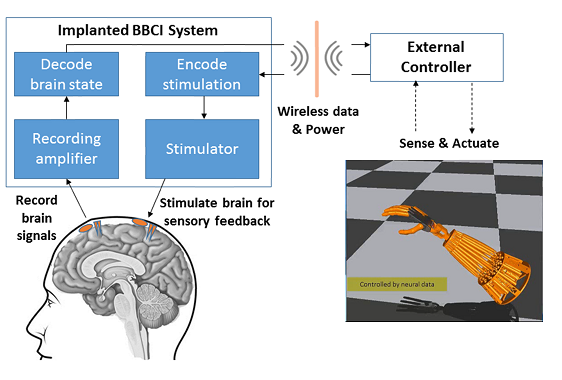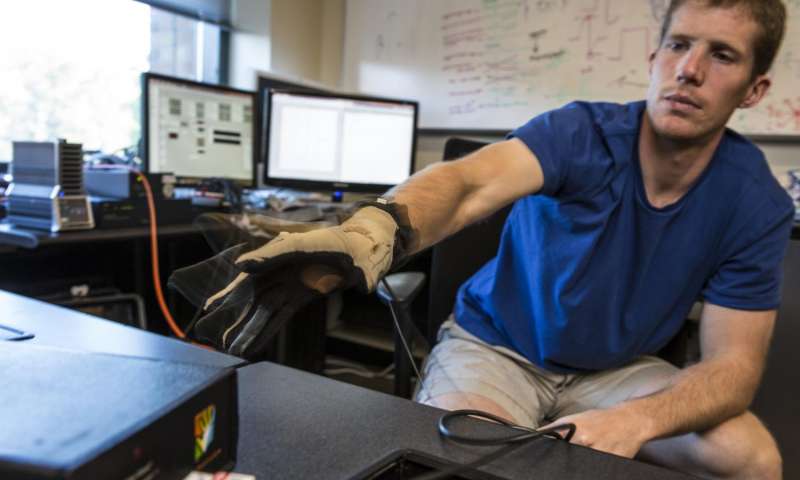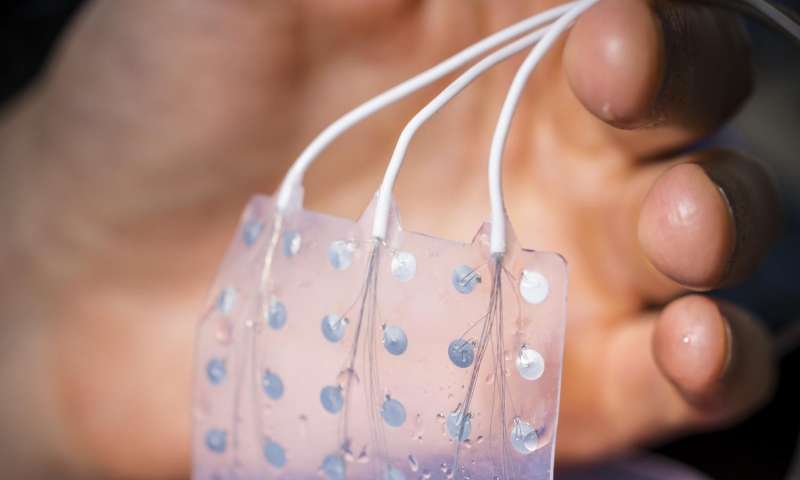
The UW study is based on the concept of closed-loop ‘bi-directional brain-computer interfaces’ (BBCIs) being developed at the CSNE that can both record from and stimulate the nervous system. They would also allow the brain to directly control prosthetics or other external devices to enhance movement or reanimate paralyzed limbs. (Credit: Center for Sensorimotor Neural Engineering).
In the quest to restore movement to people with spinal cord injuries, researchers have focused on getting brain signals to disconnected nerves and muscles that no longer receive messages that would spur them to move.
But grasping a cup or brushing hair or cooking a meal requires other feedback that has been lost in amputees and individuals with paralysis—a sense of touch. The brain needs information from a fingertip or limb or external device to understand how firmly a person is gripping or how much pressure is needed to perform everyday tasks.
Now, University of Washington researchers at the National Science Foundation Center for Sensorimotor Neural Engineering (CSNE) have used direct stimulation of the human brain surface to provide basic sensory feedback through artificial electrical signals, enabling a patient to control movement while performing a simple task: opening and closing his hand.
It’s a first step towards developing “closed loop,” bi-directional brain-computer interfaces (BBCIs) that enable two-way communication between parts of the nervous system. They would also allow the brain to directly control external prosthetics or other devices that can enhance movement—or even reanimate a paralyzed limb—while getting sensory feedback.
The results of this research will be published in the Oct.-Dec. 2016 issue of IEEE Transactions on Haptics. An early-access version of the paper is available online.
“We were able to provide a baseline degree of sensory feedback by direct cortical stimulation of the brain,” said lead author and UW bioengineering doctoral student Jeneva Cronin. “To our knowledge this is the first time it’s been done in a human patient who was awake and performing a motor task that depended on that feedback.”
The team of bioengineers, computer scientists and medical researchers from the CSNE and UW’s GRIDLab used electrical signals of different current intensities, dictated by the position of the patient’s hand measured by a glove he wore, to stimulate the patient’s brain that had been implanted with electrocorticographic (ECoG) electrodes.

CSNE M.D./Ph.D. student and GRIDLab member David Caldwell tests the hardware used for stimulating and recording a patient’s brain surface, along with a cyber glove to track hand joint angles and finger motions. (Credit: Mark Stone/ University of Washington).
“The question is: Can humans use novel electrical sensations that they’ve never felt before, perceive them at different levels and use this to do a task? And the answer seems to be yes,” said co-author and UW bioengineering doctoral student James Wu. “Whether this type of sensation can be as diverse as the textures and feelings that we can sense tactilely is an open question.”
It’s difficult for a person to mimic natural movements—whether using a prosthetic device or a limb that has become disconnected from the brain by neurological injury—without sensation. Though there are devices to assist patients with paralysis or who have undergone amputations with basic function, being able to feel again ranks highly on their priorities, researchers said.
Restoring this sensory feedback requires developing an “artificial” language of electrical signals that the brain can interpret as sensation and incorporate as useful feedback when performing a task.
The UW CSNE team frequently works with patients about to undergo epilepsy surgery who have recently had an ECoG electrode grid implanted on the surface of their brain. For several days or weeks, doctors constantly monitor their brain activity to pinpoint the origin of their seizures before operating.
By consenting to participate in research studies during this period when their brain is “wired,” these patients enable researchers to answer basic neurological questions. They can test which parts of the brain are activated during different behaviors, what happens when a certain region of the brain’s cortex is stimulated and even how to induce brain plasticity to promote rehabilitation and healing across damaged areas.
The potential to use ECoG electrodes implanted on the surface of the brain in future prosthetic or rehabilitative applications offers several advantages—the signals are stronger and more accurate than sensors placed on the scalp, but less invasive than ones that penetrate the brain, as in a recent study by University of Pittsburgh researchers.

This type of electrocorticography (ECoG) grid, which is implanted in patients about to undergo epilepsy surgery, enables researchers to record and transmit electrical signals to and from the surface of the brain. (Credit: Mark Stone/University of Washington),
In the UW study, three patients wore a glove embedded with sensors that provided data about where their fingers and joints were positioned. They were asked to stay within a target position somewhere between having their hands open and closed without being able to see what that target position was. The only feedback they received about the target hand position was artificial electrical data delivered by the research team.
When their hands opened too far, they received no electrical stimulus to the brain. When their hand was too closed – similar to squeezing something too hard – the electrical stimuli was provided at a higher intensity.
One patient was able to achieve accuracies in reaching the target position well above chance when receiving the electrical feedback. Performance dropped when the patient received random signals regardless of hand position, suggesting that the subject had been using the artificial sensory feedback to control hand movement.
Providing that artificial sensory feedback in a way that the brain can understand is key to developing prosthetics, implants or other neural devices that could restore a sense of position, touch or feeling in patients where that connection has been severed.
“Right now we’re using very primitive kinds of codes where we’re changing only frequency or intensity of the stimulation, but eventually it might be more like a symphony,” said co-author Rajesh Rao, CSNE director and UW professor of computer science & engineering.
“That’s what you’d need to do to have a very natural grip for tasks such as preparing a dish in the kitchen. When you want to pick up the salt shaker and all your ingredients, you need to exert just the right amount of pressure. Any day-to-day task like opening a cupboard or lifting a plate or breaking an egg requires this complex sensory feedback.”




